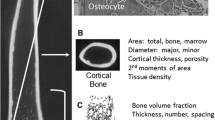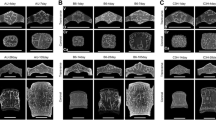Abstract
Compensatory interactions among adult skeletal traits are critical for establishing strength but complicate the search for fracture susceptibility genes by allowing many genetic variants to exist in a population without loss of function. A better understanding of how these interactions arise during growth will provide new insight into genotype-phenotype relationships and the biological controls that establish skeletal strength. We tested the hypothesis that genetic variants affecting growth in width relative to growth in length (slenderness) are coordinated with movement of the inner bone surface and matrix mineralization to match stiffness with weight-bearing loads during postnatal growth. Midshaft femoral morphology and tissue-mineral density were quantified at ages of 1 day and at 4, 8, and 16 weeks for a panel of 20 female AXB/BXA recombinant inbred mouse strains. Path Analyses revealed significant compensatory interactions among outer-surface expansion rate, inner-surface expansion rate, and tissue-mineral density during postnatal growth, indicating that genetic variants affecting bone slenderness were buffered mechanically by the precise regulation of bone surface movements and matrix mineralization. Importantly, the covariation between morphology and mineralization resulted from a heritable constraint limiting the amount of tissue that could be used to construct a functional femur. The functional interactions during growth explained 56-99% of the variability in adult traits and mechanical properties. These functional interactions provide quantitative expectations of how genetic or environmental variants affecting one trait should be compensated by changes in other traits. Variants that impair this process or that cannot be fully compensated are expected to alter skeletal growth leading to underdesigned (weak) or overdesigned (bulky) structures.







Similar content being viewed by others
References
Akhter MP, Wells DJ, Short SJ, Cullen DM, Johnson ML et al (2004) Bone biomechanical properties in LRP5 mutant mice. Bone 35:162–169
Bailey DW (1986) Genes that affect morphogenesis of the murine mandible. Recombinant-inbred strain analysis. J Hered 77:17–25
Belknap JK (1998) Effect of within-strain sample size on QTL detection and mapping using recombinant inbred mouse strains. Behav Genet 28:29–38
Brear K, Currey JD, Pond CM (1990) Ontogenetic changes in the mechanical properties of the femur of the polar bear Ursus maritimus. J Zool Lond 222:49–58
Carrier D, Leon LR (1990) Skeletal growth and function in the California gull (Larus californicus). J Zool Lond 222:375–389
Cheverud JM (1982) Phenotypic, genetic, and environmental morphological integration in the cranium. Evolution 36:499–516
Cheverud JM (1996) Developmental integration and the evolution of pleiotropy. Am Zool 36:44–50
Cheverud JM, Ehrich TH, Vaughn TT, Koreishi SF, Linsey RB et al (2004) Pleiotropic effects on mandibular morphology II: differential epistasis and genetic variation in morphological integration. J Exp Zoolog B Mol Dev Evol 302:424–435
Churchill GA, Doerge RW (1994) Empirical threshold values for quantitative trait mapping. Genetics 138:963–971
Courtland H-W, Nasser P, Goldstone AB, Spevak L, Boskey AL et al (2008) Fourier transform infrared imaging microspectroscopy and micromechanical testing reveal intra-species variation in mouse bone mineral composition and matrix maturity. Calcif Tissue Int 83:342–353
Csete ME, Doyle JC (2002) Reverse engineering of biological complexity. Science 295:1664–1669
Currey JD, Alexander RM (1985) The thickness of the walls of tubular bones. J Zool Lond 206:453–468
Currey JD, Butler G (1975) The mechanical properties of bone tissue in children. J Bone Joint Surg Am 57:810–814
Enlow DH (1963) Principles of bone remodeling; an account of post-natal growth and remodeling processes in long bones and the mandible. Charles C. Thomas Publisher, Springfield, IL
Forwood MR, Bailey DA, Beck TJ, Mirwald RL, Baxter-Jones AD et al (2004) Sexual dimorphism of the femoral neck during the adolescent growth spurt: a structural analysis. Bone 35:973–981
Frost HM (1987) Bone “mass” and the “mechanostat”: a proposal. Anat Rec 219:1–9
Grace JB (2006) Structural equation modeling and natural systems. Cambridge University Press, Cambridge
Heinrich R (1999) Ontogenetic changes in mineralization and bone geometry in the femur of muskoxen (Ovibos moschatus). J Zool Lond 247:215–223
Jepsen KJ, Pennington DE, Lee YL, Warman M, Nadeau J (2001) Bone brittleness varies with genetic background in A/J and C57BL/6 J inbred mice. J Bone Miner Res 16:1854–1862
Jepsen KJ, Akkus OJ, Majeska RJ, Nadeau JH (2003) Hierarchical relationship between bone traits and mechanical properties in inbred mice. Mamm Genome 14:97–104
Jepsen KJ, Hu B, Tommasini SM, Courtland H-W, Price C et al (2007) Genetic randomization reveals functional relationships among morphologic and tissue-quality traits that contribute to bone strength and fragility. Mamm Genome 18:492–507
Klein RF, Turner RJ, Skinner LD, Vartanian KA, Serang M et al (2002) Mapping quantitative trait loci that influence femoral cross-sectional area in mice. J Bone Miner Res 17:1752–1760
Klingenberg CP, Mebus K, Auffray JC (2003) Developmental integration in a complex morphological structure: how distinct are the modules in the mouse mandible? Evol Dev 5:522–531
Klingenberg CP, Leamy LJ, Cheverud JM (2004) Integration and modularity of quantitative trait locus effects on geometric shape in the mouse mandible. Genetics 166:1909–1921
Marder E, Goaillard JM (2006) Variability, compensation and homeostasis in neuron and network function. Nat Rev Neurosci 7:563–574
McMahon T (1973) Size and shape in biology. Science 179:1201–1204
Moro M, van der Meulen MC, Kiratli BJ, Marcus R, Bachrach LK et al (1996) Body mass is the primary determinant of midfemoral bone acquisition during adolescent growth. Bone 19:519–526
Nadeau JH, Topol EJ (2006) The genetics of health. Nat Genet 38:1095–1098
Nadeau JH, Burrage LC, Restivo J, Pao YH, Churchill G et al (2003) Pleiotropy, homeostasis, and functional networks based on assays of cardiovascular traits in genetically randomized populations. Genome Res 13:2082–2091
Nowlan NC, Prendergast PJ (2005) Evolution of mechanoregulation of bone growth will lead to non-optimal bone phenotypes. J Theor Biol 235:408–418
Olson EC, Miller RL (1958) Morphological integration. The University of Chicago Press, Chicago
Papadimitriou HM, Swartz SM, Kunz TH (1996) Ontogenetic and anatomic variation in mineralization of the wing skeleton of the Mexican free-tailed bat, Tadarida brasiliensis. J Zool Lond 240:411–426
Pigliucci M (2001) Phenotypic plasticity: beyond nature and nurture. Johns Hopkins University Press, Baltimore, MD
Pigliucci M, Preston K (2004) Phenotypic integration. Studying the ecology and evolution of complex phenotypes. Oxford University Press, New York
Price CP, Herman BC, Lufkin T, Goldman HM, Jepsen KJ (2005) Genetic variation in bone growth patterns defines adult mouse bone fragility. J Bone Miner Res 20:1983–1991
Rauch F (2005) Bone growth in length and width: the Yin and Yang of bone stability. J Musculoskelet Neuronal Interact 5:194–201
Rosen CJ, Dimai HP, Vereault D, Donahue LR, Beamer WG et al (1997) Circulating and skeletal insulin-like growth factor-I (IGF-I) concentrations in two inbred strains of mice with different bone mineral densities. Bone 21:217–223
Rosen CJ, Ackert-Bicknell CL, Adamo ML, Shultz KL, Rubin J et al (2004) Congenic mice with low serum IGF-I have increased body fat, reduced bone mineral density, and an altered osteoblast differentiation program. Bone 35:1046–1058
Ruff C, Holt B, Trinkaus E (2006) Who’s afraid of the big bad Wolff? “Wolff’s law” and bone functional adaptation. Am J Phys Anthropol 129:484–498
Rutherford SL (2000) From genotype to phenotype: buffering mechanisms and the storage of genetic information. Bioessays 22:1095–1105
Rutherford SL, Lindquist S (1998) Hsp90 as a capacitor for morphological evolution. Nature 396:336–342
Seeman E (2004) The growth and age-related origins of bone fragility in men. Calcif Tissue Int 75:100–109
Sharkey NA, Lang DH (2007) Genes in context: probing the genetics of fracture resistance. Exerc Sport Sci Rev 35:86–96
Sieberts SK, Schadt EE (2007) Moving toward a system genetics view of disease. Mamm Genome 18:389–401
Sumner DR, Andriacchi TP (1996) Adaptation to differential loading: comparison of growth-related changes in cross-sectional properties of the human femur and humerus. Bone 19:121–126
Tanck E, Hannink G, Ruimerman R, Buma P, Burger EH et al (2006) Cortical bone development under the growth plate is regulated by mechanical load transfer. J Anat 208:73–79
Tommasini SM, Nasser P, Hu B, Jepsen KJ (2008) Biological co-adaptation of morphological and composition traits contributes to mechanical functionality and skeletal fragility. J Bone Miner Res 23:236–246
Turner CH, Hsieh YF, Muller R, Bouxsein ML, Baylink DJ et al (2000) Genetic regulation of cortical and trabecular bone strength and microstructure in inbred strains of mice. J Bone Miner Res 15:1126–1131
van der Meulen MC, Ashford MW Jr, Kiratli BJ, Bachrach LK, Carter DR (1996) Determinants of femoral geometry and structure during adolescent growth. J Orthop Res 14:22–29
van der Meulen MC, Jepsen KJ, Mikic B (2001) Understanding bone strength: size isn’t everything. Bone 29:101–104
Wergedal JE, Sheng MH, Ackert-Bicknell CL, Beamer WG, Baylink DJ (2005) Genetic variation in femur extrinsic strength in 29 different inbred strains of mice is dependent on variations in femur cross-sectional geometry and bone density. Bone 36:111–122
Wright S (1921) Correlation and causation. J Agric Res 20:557–585
Yakar S, Rosen CJ, Beamer WG, Ackert-Bicknell CL, Wu Y et al (2002) Circulating levels of IGF-1 directly regulate bone growth and density. J Clin Invest 110:771–781
Zebaze RM, Jones A, Knackstedt M, Maalouf G, Seeman E (2007) Construction of the femoral neck during growth determines its strength in old age. J Bone Miner Res 22:1055–1061
Acknowledgments
This project was supported by grants AR44927 and RR12305 from the National Institutes of Health.
Author information
Authors and Affiliations
Corresponding author
Rights and permissions
About this article
Cite this article
Jepsen, K.J., Hu, B., Tommasini, S.M. et al. Phenotypic integration of skeletal traits during growth buffers genetic variants affecting the slenderness of femora in inbred mouse strains. Mamm Genome 20, 21–33 (2009). https://doi.org/10.1007/s00335-008-9158-1
Received:
Accepted:
Published:
Issue Date:
DOI: https://doi.org/10.1007/s00335-008-9158-1




